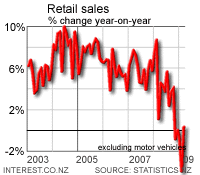 Core seasonally adjusted retail sales (excluding fuel and car sales) were flat in June from May, which was better than the fall that most economists had expected. (Updated to include comments from JP Morgan). But once the inflationary effects of higher food and fuel prices are extracted, it's clear that retail spending is depressed and depressed enough to encourage the Reserve Bank to cut interest rates again on September 11. Seasonally adjusted sales at 1995 prices (ie real) fell to NZ$14.100 billion in the June quarter from NZ$14.315 billion in the March quarter and is also down from the NZ$14.434 billion in the same quarter a year ago. Seasonally adjusted sales fell sharply in department stores (-8.7%) in June from May, which will hurt the likes of The Warehouse, Farmers and Briscoes. Hardware retailing (Bunnings Warehouse, Mitre 10, Placemakers) fell 2.9%. However, appliance retailing rose 4.4% and cafe and restaurant retailing rose 3.5%.JP Morgan economist Helen Kevans said retail sales fell 1.5% in real terms in the June quarter, the largest fall on record, although it was less than the economist consensus forecast for a 1.8% fall. Here's here comments verbatim.
Core seasonally adjusted retail sales (excluding fuel and car sales) were flat in June from May, which was better than the fall that most economists had expected. (Updated to include comments from JP Morgan). But once the inflationary effects of higher food and fuel prices are extracted, it's clear that retail spending is depressed and depressed enough to encourage the Reserve Bank to cut interest rates again on September 11. Seasonally adjusted sales at 1995 prices (ie real) fell to NZ$14.100 billion in the June quarter from NZ$14.315 billion in the March quarter and is also down from the NZ$14.434 billion in the same quarter a year ago. Seasonally adjusted sales fell sharply in department stores (-8.7%) in June from May, which will hurt the likes of The Warehouse, Farmers and Briscoes. Hardware retailing (Bunnings Warehouse, Mitre 10, Placemakers) fell 2.9%. However, appliance retailing rose 4.4% and cafe and restaurant retailing rose 3.5%.JP Morgan economist Helen Kevans said retail sales fell 1.5% in real terms in the June quarter, the largest fall on record, although it was less than the economist consensus forecast for a 1.8% fall. Here's here comments verbatim.
This was the first time since June 1998 that volumes have fallen in two consecutive quarters "“ in 1Q sales volumes fell 1.2%q/q. Weak private consumption growth was a key driver of the contraction in the economy in 1Q, when GDP growth declined 0.3%q/q. Our forecast calls for GDP growth of -0.5%q/q in 2Q, meaning New Zealand's economy will have endured a technical recession in the first half of 2008. This recession, though, is likely to be prolonged, with our forecast calling for another contraction in the economy in 3Q (-0.3%q/q). Consumers in New Zealand will continue to face significant headwinds in coming months, owing partly to the negative wealth effects from the sharp deterioration in the housing market, high interest rates, and elevated petrol prices. Furthermore, weak business confidence suggests that companies will become increasingly reluctant to hire workers, meaning that the unemployment rate will trend north. While the near-term outlook for retailers is bleak, some improvement in sales can be expected toward the end of 2008 and into 2009 now that the RBNZ has embarked on what is likely to be an extended easing cycle. We maintain our forecast that the RBNZ will cut the OCR by another 25bp in September, October, and December, taking the key rate to 7.25% by year end.

We welcome your comments below. If you are not already registered, please register to comment.
Remember we welcome robust, respectful and insightful debate. We don't welcome abusive or defamatory comments and will de-register those repeatedly making such comments. Our current comment policy is here.